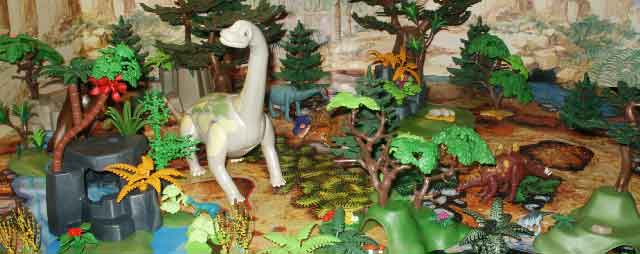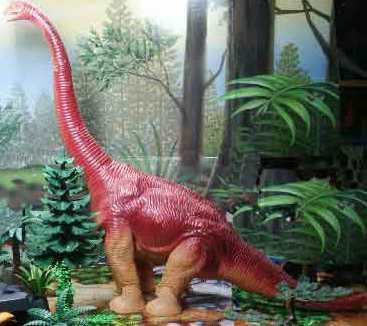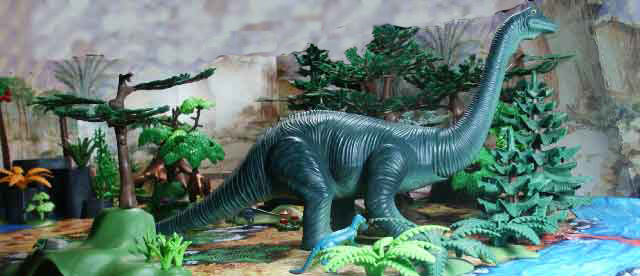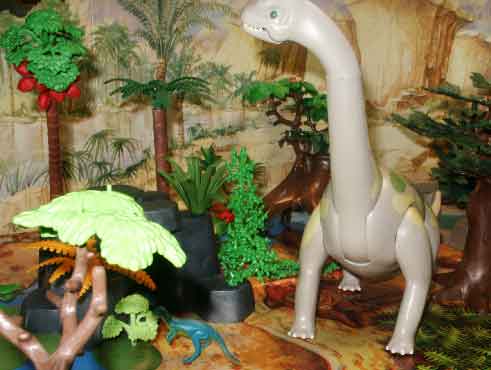
PlayMobil Brachiosaurus and K&M Wild Republic Stegosaurus and Apatosaurus.
Late Jurassic
from the Dinosaur Collector
Plant communities in the mesozoic would have been very different from modern ecosystems. Plants in the Mesozoic differed and evolved over time. In the Jurassic Pangea, world continent is breaking up and this would have disrupted the climate. The Cycadiods typical of the Late Triassic and Early Jurassic are rare as are the giant scale trees and club mosses of the paleozoic. The climate at the end of the Middle Jurassic is drying out. The equator is arid. Cycadophytes and conifers dominate the arid ecology as it spreads north and south. Further north conifers, Gingko and Czekanowskiales are more common. areas with seasonal rain may have fern parries. Fern , herbs and cycads would have made up the low level plant life. Trees have gotten very tall like red woods (sequoia) and monkey puzzles (araucaria). Foliage is concentrated at the tops giving the lollipop tree look. The plants grow slow and are hard to digest.
UPDATED 9/10/08
Jurassic Diorama Other Pages
Use the menus above to find Diorama of Jurassic fauna
The modern jungle ecosystem doesn't exist. There is no grass and during the dry season large areas would have been barren. The climate model is extreme monsoons alternating with long arid periods for the Morrison. The extinct Czekanowskiales were a major plant group in the Jurassic they had long pine needle leaves. Gingkoes have fan shaped leaves. The Morrison model is like that of a modern Araucaria forest with widely separated trees rather the northern pine forests. Cycadophytes the cycads and cycadeoids are wide spread. The cycadeoids are declining, some superficially look like palm trees others like barrels. Horsetails are present as among the last hold over from the Paleozoic flora.

PlayMobil Brachiosaurus
and K&M Wild Republic Stegosaurus and Apatosaurus.
Ornithiscians don't get large. Stegosaurus and Camptosaurus were the medium size plant eaters. Stegosaurus was able to rear up on its hind legs to feed higher. When the plants change in the Cretaceous stegosaurs die out but their relatives get large.

Stegosaurus from Chap Mei.
Ultrasaurus later renamed Ultrasuros was though to be giant brachiosaur. It was later decided that the original find was actually a mix of Supersaurus and Brachiosaurus bone so is now nomium dubium.

The Ultrasaurus figure above from Definitely Dinosaurs.
Diplodocus was the second most common sauropod in North America with relatives in Africa and South America. It was very similar to it relatives Apatosaurus and Barosurus.

Diplodocus from Tyco Dinoriders.
Allosaurus is the most wide spread theropod of the Jurassic but with many of the associations based on questionable finds. The key defining features are the three fingered claws and horn above the eyes.

This articulated Allosaurus is from the Hasbro Jurassic Park series and a personal favorite.
Sauropods flourish in the Late Jurassic. When the trees get bigger the sauropods replace the prosauropods that dominate the first part of the Mesozoic. Sauropods had been around since the Late Triassic but were rare. These animals master large size and no land animals will ever be bigger. Brachiosaurids appear in the Middle Jurassic and are important in the Early Cretaceous. They are the ancestors of the titianosaurus that dominate Gondwanaland in the Cretaceous.

Brachiosaurus PlayMobil and x from Yowie collection.
return to Mesozoic Menu
 Click on the Site A
icon for Dioramas organized by period or by manufacturer.
Click on the Site A
icon for Dioramas organized by period or by manufacturer.